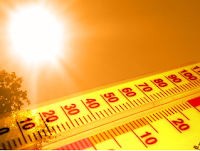#10 - Warm and ''Dusty'' April
| Fire along I-29 in ND. Credit: The Grand Forks Herald |
Another burst of warmth occurred at the end of April with highs in the high twenties. A high of 27.4°C on April 30 was the warmest in April since 2001. In the end, April averaged 5.4°C, tied 36th warmest since 1872. Daytime highs were the most anomalous, averaging 13.2°C, 2.3°C above normal and tied 20th warmest. 6 days exceeded 20°C, the most since 2010 and above the normal of 4 days. The first 20°C of the year occurred on April 11, almost a month earlier than in 2013 and 2014.
#9 - Mild January and a Winter With Little Snow
After a frigid start to 2015, a warm spell blessed southern Manitoba with above normal temperatures in the second half of January. A 17-day streak of above normal temperatures occurred from January 14 to 30. During this period, daily highs averaged -1.9°C and daily lows average -12.1°C. These were about 10°C warmer than normal for the period. At the Winnipeg International Airport, 6 days exceeded the freezing mark and 6 days never saw temperatures dip below -10°C. The warmest days were January 22 and 23 when temperatures soared into the mid single digits. The airport reached 3.7°C and 3.1°C respectively, but it was even warmer inside Winnipeg with highs between 4 and 6°C recorded. Some parts of southern Manitoba never even dipped below freezing on January 23. The extended warm spell melted what little snow was on the ground. In addition, only 5 cm of new snow fell between January 4 and 31. By the end of the month, snow depth in Winnipeg was just 12 cm, the 12th thinnest on record since 1941.Several days of gloomy skies and freezing drizzle also occurred during the warm spell. 5 days saw liquid precipitation in the form of drizzle, freezing drizzle or light rain. Less than 1 mm of accumulation occurred.
In the end, January averaged -13.7°C, tied with 2010 for 19th warmest since 1873.
December was also very mild. The December to January period averaged -11.9°C, the 17th warmest on record since 1872. Thanks to a frigid February, the winter as a whole only tied for 33rd warmest and averaged -14.3°C. 43 cm of snow fell from December to February, the 28th least snowy winter. However, only about 31 mm of precipitation fell, making it the 9th driest winter on record since 1872.
#8 - A Very Humid Summer
Despite near normal temperatures, very high humidity occurred in summer 2015. With an average dewpoint of 13.6°C, summer 2015 tied with 1996 for 4th most humid summer on record since 1953. Interestingly, 9 of the last 20 summers were among the top 10 most humid summers. 22 days from June to August saw dewpoints exceed 20°C in Winnipeg this summer, the 2nd most 20°C dewpoint days since 1953. The 1981-2010 normal is just 10 days. 8 daily high and high minimum dewpoint records were broken during the period.Table: Top 10 most humid summers (Jun-Jul-Aug) since 1953 (by average dewpoint temperature):
1. 14.3°C (2010)
2. 14.1°C (2012)
3. 13.7°C (2005)
4. 13.6°C (1996, 2015)
6. 13.5°C (1955, 1995, 1998)
9. 13.4°C (2001)
10. 13.3°C (1963, 1983, 2003)
July was most humid. With an average dewpoint of 16.1°C, it was the 2nd most humid July and month on record since 1953. The 1981-2010 normal is 14.2°C. The month featured an 8-day streak with dewpoints over 20°C mid month. A maximum dewpoint of 24.1°C was achieved on July 12, breaking the old record of 23.9°C in 1955 for the day. In total, an amazing 14 days saw dewpoints over 20°C, tied with 1957 for the most 20°C dewpoint days in July on record since 1953.
Table: Top 5 most humid Julys since 1953 (according to average hourly dewpoint observation)
1. 16.5°C (2012)
2. 16.1°C (2015)
3. 15.5°C (1966, 1989)
5. 15.4°C (1955, 1983, 2007, 2010)
Table: Top 6 most 20°C dewpoint days in July since 1953
1. 14 days (1957, 2015)
3. 12 days (1955, 2001, 2005)
6. 11 days (1966)
In August, the main story was mid month when a 5-day heat wave hit southern Manitoba. Temperatures soared over 30°C on each of these 5 days and in some cases, over 32°C. The hottest day was August 14 when temperatures soared into the mid thirties. Records were broken, including in Brandon (36.6°C). High humidity accompanied the heat wave with 4 days of dewpoints over 20°C. Dewpoint temperatures peaked at 24.5°C in Winnipeg on August 15, shattering the old record of 21.7°C in 1972 for the day. It was also the latest occurrence of dewpoint over 24°C in a year since 1953. High minimum temperature records were also broken in Winnipeg (21.2°C) and Morden (22.0°C).


No comments:
Post a Comment